 Image search results - "Shiga" Image search results - "Shiga" |

Three-day (Aug. 9-11, 2006) rowing route around the southern half of the lake by the Kyoto Univ. rowing club.1st day: Home base in Seta River to Manohama (crew change), then to Omi-Maiko.
2nd day: Omi-Maiko to Manohama, then to Chomeiji.
3rd day: Chomeiji to Manohama where crew changes. Then to home base in Seta River.
|
|

The Kusatsu Shukuba Matsuri Festival is held on April 29 to celebrate Kusatsu's history as a post town on the Nakasendo and Tokaido Roads. Numerous events and activities are held such as flea markets, street & stage performances, and Japanese danThis was the first time I saw hula dancing in Shiga. Surprised to see hula dancing (Kusatsu Station plaza).
|
|

Very little remains of Otowa castle originally built by Lord Gamou Sadahide. Two battles took place here in 1496 and 1503. Road to Otowa Castle on the hill seen on the left.
|
|

Hino was home to many Omi merchants who plied up and down Japan during the Edo Period to sell and trade their wares. They became quite successful selling medicines, lacquerware, sake, etc. Those from Hino were called Hino shonin (Hino merchants).
|
|

Hino's most prominent shrine is best known for the Hino Matsuri festival on May 2-3. The shrine was originally atop Mt. Watamuki, Hino's tallest mountain. It was moved to its present location in 796.
|
|
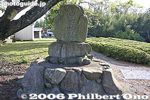
Nakano Castle, also known as Hino Castle, built in 1534 by Lord Gamou Sadahide (1508-1579). In 1582, when Oda Nobunaga was assassinated in Kyoto, Lord Gamo Katahide brought Nobunaga's wife and children from Azuchi Castle to Hino Castle for their safe
|
|
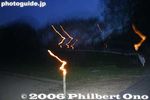
Held annually on May 4, the Misaki Shrine Fire Festival (hi-matsuri) has local people carry 2-meter long torches from their homes to the shrie where a 5-meter tall pile of bamboo is lit to make a towering inferno.A taiko drum is also carried and beaten.
|
|

Azuchi Nobunaga Matsuri used to be held on the first Sunday in June, but it's now held in Nov. (since 2020). The festival is dedicated to Oda Nobunaga who built Azuchi Castle. Parking available at nearby Bungei no Sato.
|
|

Road marker. Established in 1642, Moriyama-juku was the sixty-seventh of the sixty-nine stations or shukuba post towns on the Nakasendo Road. It is the eighth Nakasendo station in Shiga (following Musa-juku in Omi-Hachiman).
|
|

Three boats are used for the trip, sighted here off shore near JR Hira Station on the Kosei Line. 湖西線比良駅の沖
|
|

Held for two evenings on Aug. 14-15 during the obon season, people light their torches at Gosha Shrine and proceed to Hibarino park where the torches are thrown up to a large pine tree. The more torches get stuck on the tree, the better the next harvest.This is Hibarino park. The pine tree on the right of the small hill is the target for the torches. This park also serves as the Otabisho during the Hino Festival.
|
|
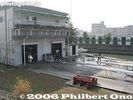
Seta Rowing Club's 2-story clubhouse located in Otsu, Shiga Prefecture. The club is a registered NPO. The club is named after Seta River at the southern tip of Lake Biwa. Regattas are also held on the river, Lake Biwa's sole outflowing river.
|
|
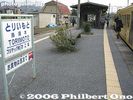
Toriimoto-juku is the sixty-third of the sixty-nine stations or shukuba post towns on the Nakasendo Road. It is the fourth Nakasendo station in Shiga (following Bamba-juku in Maibara), and one of ten Nakasendo stations in Shiga.
|
|

PR poster designed by Tetsuo OshiroPoster for the race.
京都大学ボート部OBの尾城徹雄様に作成したポスター。大学内や大津市石山商店街などで張り出された。
|
|

Lake Biwa is near the center of Honshu island between Nagoya and Kyoto.
|
|
|

Barrels of Hino merchant sake
|
|
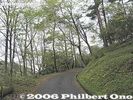
The castle is somewhat out of the way. It's a 15-min. walk from the nearest bus stop.
|
|

Later the shrine became Lord Gamou's family shrine and it was revered by Hino merchants during the Edo Period. This is the Shrine grounds. Map
|
|

The castle was abandoned in 1597. Only a few stone walls and shrines remain adjacent to Hinokawa Dam. This is one entrance to Nakano Castle. Map
|
|
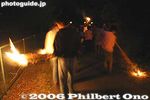
Procession of local residents carrying torches to the shrine. Map
|
|

Being my first regatta, I was at first daunted by the rowing terminology for the different types of boats.
|
|

The Azuchi Nobunaga Festival's main venue was here, next to Azuchi Castle (hill on right). MAP
|
|

Road marker. Go right for the Nakasendo Road. MAP
|
|

Arriving Omi-Maiko on Day 1. Rowing around the lake has been an annual tradition.
|
|

Entrance to Gosha Shrine. 五社神社
|
|

Seta Rowing Club's clubhouse. Boats are stored on the bottom floor, while the 2nd floor has office space, ergo machines, meeting room, locker room, etc. Web site here
|
|
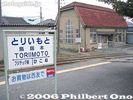
Although the Honjin is long gone, there are a few reminders of its shukuba past. Near Ohmi Railways Toriimoto Station. Map
|
|

The shrine also holds the Hino Matsuri on May 2-3.
|
|

The Kusatsu-juku Honjin is decorated with curtains. MAP
|
|
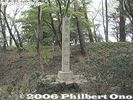
The castle met its demise in 1522 less than 60 years after it was built, after a war within the Gamou Clan. It now serves as a large hilltop park with good views of the surroundings. Otowa Castle marker
|
|
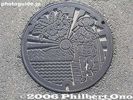
Manhole with the symbol of Hino merchant, Shiga Prefecture
|
|

Torii at Umamioka Watamuki Shrine in Hino, Shiga Pref.
|
|

Path to Nakano Castle ruins
|
|
|

Carrying back a single sculling boat
|
|
|
|
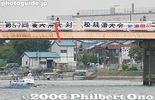
Karahashi Bridge as the starting point for alumni races
|
|

Rear of road marker
|
|
|

Gosha Shrine torii
|
|
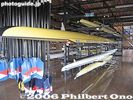
Oars and boats stored on the bottom floor. The club offers 2-hour rowing lessons on Sundays during May to Nov. Address: 6-1 Ogaya, Otsu, Shiga 520-2144 Japan. Phone/Fax: 077-545-9961, Email: info@setarc.jp
|
|
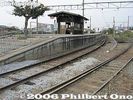
Ohmi Railways Toriimoto Station platform
|
|

Shukuba Odori dance in the shopping arcade.Held 11:00 - 12:00
|
|

Suzuka Quasi-National Park markerThe area is within this park.
|
|

Omi Hino Merchant House. The former home of Hino merchant Yamanaka Hyouemon was donated to the town in 1981. Now a museum exhibiting the history and artifacts of the Hino merchants. 近江日野商人館Small admission charged. Open 9 am to 4 pm, closed on Mon. and Fri. Close to the center of town.
Address: Okubo 1011, Hino-cho
Phone No.: 0748-52-0007
山中兵右衛門
|
|

Stone bridge
|
|
|
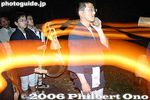
The torch procession rings out.
|
|

The place was not as crowded as you would think.
|
|

Stage entertainment (Azuchi Castle ruins in background).
|
|

Marker for the Kabuto-ya inn
|
|

They use four-man boats (called "knuckle four" in Japanese) with sliding seats. It is stable and safe, ideal for beginners.
|
|
|
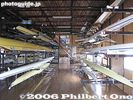
Many boats are made in Italy.
|
|

Ohmi Railways Toriimoto Station building
|
|

To mark the song's 100th anniversary, a new song monument was unveiled at Kyoto University (Yoshida-South Campus) on Nov. 25, 2017.
|
|

Start of Kusatsu Jidai Gyoretsu Procession 草津時代行列
|
|

Entrance to castle grounds, now a picnic and playground.
|
|
|

Stone bridge
|
|

Nakano (Hino Castle) in Hino, Shiga Pref. The castle was built in 1534 by Lord Gamou Sadahide (1508-1579).
|
|

Towering inferno of bamboo on fire. The shrine has a 5-meter tall pile of bamboo which is lit to make a towering inferno within the shrine grounds. Very dramatic.
|
|

Rowing team from Nagahama
|
|

Demonstration of matchlock guns, Azuchi Nobunaga Festival in Azuchi, Omi-Hachiman.
|
|

Kyoto Univ. in dark blue T-shirts
|
|

Old Nakasendo Road and Dobashi Bridge. Supposedly, this is the bridge from where Hiroshige drew his print of Moriyama-juku.
|
|

Each boat has four rowers and cox who steers the rudder.
|
|
|
|
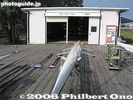
Right across the clubhouse is the Annex boat house.
|
|

Ohmi Railways Toriimoto Station building
|
|

Front side of the monument has the Japanese lyrics and explanation of the song. Monument is made of stainless steel with a brushed-metal finish.
|
|
|
|

Castle monument
|
|

Inside Omi Hino Merchant House近江日野商人館
|
|
|
|
|
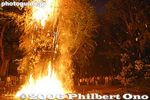
Misaki Shrine Fire Festival in Aisho. The shrine has a 5-meter tall pile of bamboo which is lit to make a towering inferno within the shrine grounds. Very dramatic. Also see the video at YouTube.
|
|

They came from Hikone. 鉄砲隊演武(彦根鉄砲隊)
|
|
|
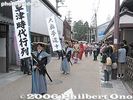
Kusatsu Shukuba Matsuri is held on April 29 to celebrate Kusatsu's history as a stage town on the Nakasendo and Tokaido Roads. The main highlight is this Kusatsu Jidai Gyoretsu procession from 11:45 am to 2 pm. This is the Tokaido Road.
|
|

Dobashi Bridge
|
|

The green boat. 近江舞子上陸
|
|

Pile of straw to be lit. The fire is used to light all the torches.
|
|
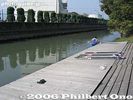
Club's boat dock. This narrow canal leads to Lake Biwa.
|
|
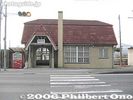
Toriimoto Station building built in 1931 when the station opened and still in use.
|
|
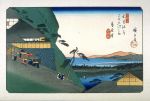
Hiroshige's woodblock print of Toriimoto (64th post town on the Nakasendo) from his Kisokaido series.
|
|
|

Karasaki Pine Tree in Kenrokuen Garden, Kanazawa, Ishikawa Pref.
|
|

Kusatsu Shukuba Festival, Shiga Pref. 大奥夢道中
|
|

Hilltop left
|
|

Lacquerware sold by Hino merchants近江日野商人館
|
|

Mikoshi portable shrine
|
|

In 1582, when Oda Nobunaga was assassinated in Kyoto, Lord Gamo Katahide brought Nobunaga's wife and children from Azuchi Castle to Hino Castle for their safety. The castle was abandoned in 1597.
|
|
|

Azaleas in full bloom along the lake edge
|
|
|
|

Finish line 300 meters later
|
|

Tomon-in temple built by Buddhist Priest Saicho (Dengyo Daishi) to protect his Enryakuji temple on Mt. Hiei from demons from the east. 東門院
|
|

The boats are wooden, and a few decades old.
|
|

White and red torii
|
|
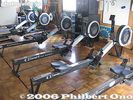
Rowing exercise machines called "ergometers" or "ergo" or "indoor rower." In Japan, they call it "ergo." エルゴThe machine measures the energy you expend rowing. Also measures how fast and far you rowed if you were on water. They even have ergo rowing contests which is a sport itself.
|
|

Toriimoto-juku is the sixty-third of the sixty-nine stations or shukuba post towns on the Nakasendo Road. It is the fourth Nakasendo station in Shiga (following Bamba-juku in Maibara), and one of ten Nakasendo stations in Shiga.
|
|
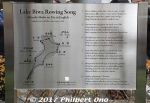
Monument's English side has a bilingual Lake Biwa map and Lake Biwa Rowing Song English lyrics.Directions: From JR Kyoto Station's Karasuma side (north side with Kyoto Tower), go to bus stop D2 and catch the No. 206 bus bound for "Gion Via Kiyomizu-dera Temple/Kitaoji Station" (三十三間堂・清水寺・祇園・百万遍). The bus leaves every 15 min. or so (bus schedule here), but it can be very crowded. The ride takes abut 30 min. Get off at "Kyodai Seimon-mae" (京大正門前). Cross the big road (Higashi-Oji-dori) and walk along Higashi-Ichijo street. The main Yoshida Campus will be on the left while the Yoshida-Minami Campus will be on the right. Enter the Yoshida-Minami Campus and walk to the central courtyard area.
(From Kyoto Station, there is also an express bus (京大快速) to Kyoto University Hospital from bus stop D3, but it runs only at certain times on weekdays, mainly in the morning and mid-afternoon (bus schedule here).
|
|

Kusatsu Shukuba Festival, Shiga Pref.
|
|

Otowa Castle's hilltop center, now a playground.In Hino, Shiga Pref.
|
|

Inside Omi Hino Merchant House
|
|

Rear view
|
|
|
|
|
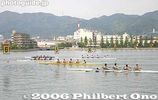
Four-man boat race. There were also foreign rowers from international schools.
|
|

Demonstration of matchlock guns, Azuchi Nobunaga Festival.Even these people had to obtain police permission to bear and fire these feudal-era guns.
|
|

Tokyo Univ. (Todai) crew return to land after a race
|
|

Kaeru frog to wish you a safe return. 東門院
|
|

Notice the rudder. Controlled by a pair of strings held by the cox.
|
|

Torches
|
|
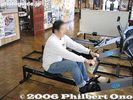
The rowing lesson starts with an ergo workout.
|
|
|
|

Hilltop right
|
|

Inside Omi Hino Merchant House
|
|
|
|
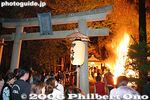
Torii at Misaki Shrine Fire Festival.
|
|

Cheering section for Nagahama
|
|

Boat ride along the moat of Azuchi Castle.
|
|
|

樹下神社
|
|

Beachgoers frolick in the lake as the rowing boats arrive.
|
|

After it gets dark, the pile of straw is lit and people come to light their torches.
|
|
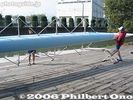
Carrying the boat.
|
|
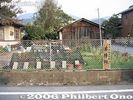
Site of Honjin Lodge
|
|

Omi Fair video taken on March 2, 2014 at Takashimaya Dept. Store in Nihonbashi, Tokyo. Funazushi, Omi beef, Biwa pearls, and more. We also saw Hiko-nyan.
|
|

Ishibe-juku was the 51st stage/post or shukuba lodging town on the Tokaido Road where even Emperor Meiji once stayed (with an entourage of over 3,000). View from JR Ishibe Station. Ishibe in Konan city is rural, yet it has a few major industries operating.
|
|

Meaning "Long Life Temple," Chojuji's Hondo temple hall is a National Treasure. It belongs to the Tendai Buddhist Sect and one of the Konan Sanzan Temple Trio along with Jorakuji and Zensuiji Temples.Chojuji temple Entrance gate + fall colors.
|
|

A stone's throw from Chojuji Temple, Jorakuji Temple (est. 708) of the Tendai Buddhist Sect boasts two National Treasures with its main hall and three-story pagoda. It is one of the Konan Sanzan Temple Trio accessible by bus from JR Ishibe Station.In the deep-green forest, you can see part of the pagoda's roof.
|
|

At 271 meters high, Mt.Hachiman-yama was the site of Hachiman Castle built by Toyotomi Hidetsugu in 1585. Now home to Zuiryuji temple of the Nichiren Sect, some of the castle's stone walls still remain. MAP
|
|

Inside Ritto Station and sign celebrating the decision to build a shinkansen station in Ritto. Celebration has been muted after the new governor was elected in July 2006.
|
|

Dedicated to Susano-O no Mikoto, Daiho Shrine is a short walk from JR Ritto Station. Main torii. MAP
|
|

Kusatsu-juku was the fifty-second station on the Tokaido Road (following Ishibe-juku) and the sixty-eighth station (following Moriyama-juku) on the Nakasendo Road. During the Edo Period, Kusatsu was an important post town at the crossroads of both roads.The roof is shaped like a Honjin lodge, with a gate. 草津駅
|
|

The 31st temple on the Saigoku (Western Japan) Pilgrimage circuit, Chomeiji (Long Life Temple) worships the Kannon goddess dedicated to long life and good health. It belongs to the Tendai Buddhist sect. This sign points the way.Accessible by bus from Omi-Hachiman Station.
|
|

Musa-juku was the sixty-sixth of the sixty-nine stations or shukuba post towns on the Nakasendo Road. It is the seventh Nakasendo station in Shiga (following Echigawa-juku in Aisho). MAPMusa was one of ten Nakasendo stations in Shiga. There is very little left. Near Ohmi Railways Musa Station, a short ride from Omi-Hachiman.
|
|

The gateway to the Seta area is Karahashi-mae Station.
|
|

Marker and side road to Lord Gamo (Gamoh) Ujisato's gravesite. Near Aizu-Wakamatsu City Hall. Gamo Ujisato (1556-1595) was a feudal lord from Hino, Shiga Pref. He built Tsurugajo Castle and named the town Wakamatsu, after a place in his hometown.
|
|

About the song and rowing route... この歌について(日本語解説)Shiga Prefecture's most famous and beloved song is called Biwako Shuko no Uta (琵琶湖周航の歌) or "Lake Biwa Rowing Song." I have rendered this song into both pictures and English, according to my own imagination and interpretation.
Please see this page for a full explanation: https://photoguide.jp/txt/Lake_Biwa_Rowing_Song
First composed in 1917 by a bunch of college students from Kyoto, the song has been recorded by many famous Japanese singers and groups. In 1971, it became a major nationwide hit with singer Tokiko Kato's rendition. Today, the song remains a favorite among choir groups in Japan, and a choir singing contest is held for the song every June (since 1997) in Imazu, the birthplace of the song in the northwestern corner of Lake Biwa.
Shiga Prefecture also has stone monuments dedicated to each of the six verses. There's even a museum (Biwako Shuko no Uta Shiryokan) in Imazu dedicated to the song. Okaya city on the shores of Lake Suwa in Nagano Prefecture, the birthplace of the song's composer, Taro Oguchi (小口太郎) (1897-1924), also has a song monument and bronze statue of him.
|
|

Otsu Exhibition, Nov. 21 - Dec. 4, 2005 at Shiga Kaikan, Otsu, Shiga. Right across from the Shiga Prefectural Office. 滋賀会館For this exhibition, I created my own photographic rendition of the places and scenes mentioned in the song and also photographed all the stone monuments dedicated to the song. I used Photoshop to composite images and to alter the colors into a dreamy condition as the song suggests. I also translated the lyrics into English.
The exhibition was held at Shiga Kaikan, right across from the Shiga Prefectural Office. Shiga Kaikan has two spaces for exhibitions, and I used the smaller space called Bunka Salon Gallery.
Map: http://www.shiga-bunshin.or.jp/shigakaikan/map.html
Address: Kyomachi 3-4-22, Otsu, Shiga Pref.
Phone: 077-525-9995
〒520-0044 大津市京町三丁目 4-22
Web site: http://www.shiga-bunshin.or.jp/shigakaikan/
|
|
|
|

Nagahama Hachimangu Shrine torii on New Year's Day. Nagahama's most popular shrine for New Year's worship (hatsumode). MAP
|
|

Inside Omi Hino Merchant House
|
|
|

Lord Ishida Mitsunari was born in 1560 in Ishida village in Nagahama, Shiga Pref. You can see the site of his birthplace by bus from Nagahama Station. Get off at the Ishida bus stop. MAPHis birthplace and former residence have monuments dedicated to this fallen but revered leader of the Western Forces which lost to Tokugawa Ieyasu at the Battle of Sekigahara in 1600. He was a protégé and main samurai retainer of Toyotomi Hideyoshi.
|
|

Sumiyoshi Shrine is on the west side of JR Moriyama Station. This side has an area called "Fuke" written with the same kanji for "uwaki" (cheating on your partner).I wonder what married couples think of living in this area...
|
|

Torii and steps to Inari Shrine
|
|
|

Road to Mt. Yukinoyama, an ancient mountain and home to over 200 tumuli built during the 5th to 7th centuries. In 2013, it was designated as a National Historic Site.
|
|
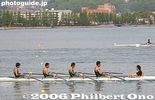
Four-man race with the cox at the stern
|
|

Verse 1 Song Monument, Otsu (Mihogasaki). In 1973, this was the first monument built for the song. The song's first and most famous line, "Ware wa Umi no Ko" is written. 一番の歌碑。大津市三保ケ崎。This monument is near the boat house in Mihogasaki, a stone's throw from Hama-Otsu.
われは湖の子 さすらいの
旅にしあれば しみじみと
のぼる狭霧や さざなみの
志賀の都よ いざさらば
Ware wa Umi no Ko, sasurai no
tabi ni shiareba, shimijimi to
Noboru sagiri ya, sazanami no
Shiga no Miyako yo, iza saraba
|
|

Ohmi Railways Toyosato Station. MAP
|
|

Itoh Chube'e Memorial House (Itoh Chube'e Ki'nenkan). Itoh Chube'e (1842-1903) was the founder of Itochu Corporation and Marubeni, two of Japan's largest trading companies, in 1858. MAPThis house displays his former residence and some of his possessions. A short walk from Toyosato Station, the house is open to the public on Tue., Thu., and Sat. Free admission.
|
|

From the Ohmi Railways' Gokasho Station, you can walk to the Fujii Hikoshiro House (藤井 彦四郎邸), which is also a history museum, and to the modern Ohmi Merchant Museum (近江商人博物館).Ohmi Railways Gokasho Station 近江鉄道五箇所駅
|
|

和船
|
|

Gokasho is famous for the grand, old homes of wealthy Omi merchants. Three of them are clustered together for us to visit inside. They are the former residences of Tonomura Uhee (外村 宇兵衛), Tonomura Shigeru (外村 繁), and Nakae Jungoro (中江
|
|

Entrance road to JRA (Japan Racing Association) Ritto Training Center. MAP
|
|

Tokyo Shiga Kenjinkai New Year's Party 2007 平成19年 東京滋賀県人会 新年賀詞交歓会Party fee was 7,000 yen.
|
|

Way to Takashimaya Dept. Store in Nihonbashi subway station.
|
|

On June 16, 2007, Imazu marked the 90th anniversary of the song by organizing a boat cruise on Lake Biwa and other events. Omi-Imazu Station had a sign directing guests to Imazu Port. 90周年の記念「琵琶湖周航クルーズ」の近江今津駅内
|
|
|

The orange boat. On the left at the ear is the cox, the middle are four rowers, and at the front of the boat is one extra person who can rest and enjoy the ride.
|
|

During July-Aug. 2007, I helped to make the Yokaichi giant kite at the annex of the Yokaichi Giant Kite Museum.where the giant kite is made. Every three years, the giant kite, flown every May in Higashi-Omi, is replaced by a new kite bearing a new design.The new kite was made during July-Aug. 2007, taking about 30 days. The kite is made by volunteers from the public under the instruction of the Yokaichi Giant Kite Preservation Society. For the first time, I helped make this giant kite which was first flown successsfully on May 25, 2008 at the annual kite festival.
|
|
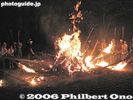
Lighting torches.
|
|

On July 29, 2007, this regatta was held for the second time. It targets mainly beginner rowers. Organized by the Seta Rowing Club which seeks to have more people enjoy water sports on Lake Biwa. Seta-Karahashi Bridge was the regatta's starting line. The Lake Biwa Rowing Song CD was awarded to all the 1st, 2nd, and 3rd place winners in all five categories.
|
|

Held during Aug. 3-5 at Taga Taisha Shrine, the Mantosai or 10,000-Lantern Festival is a night festival when numerous lanterns are lit within the shrine grounds. The lanterns are for the repose of ancestral spirits.
|
|

The 6th annual Lake Biwa Kaitsuburi (Little Grebe) Regatta was held on Sept. 16, 2007. This regatta is mainly for ordinary people of all ages wanting to row. Lake Biwa Rowing Course (Biwako Sotei-jo) in Otsu, Shiga. 滋賀県立琵琶湖漕艇場
|
|

Otsu Prince Hotel, the main venue of the 11th Shiga Kenjinkai International Convention held Nov. 12-14, 2007.
|
|

Anegawa River was the site of a major battle with Oda Nobunaga and Tokugawa Ieyasu defeating Azai Nagamasa and the Asakura clan on Aug. 9 1570. The area was left with so many dead that the river ran red.Local place names such as Chibara (Blood Field) stuck. Looking toward Nomura-bashi Bridge where the Anegawa battle monument stands.
|
|

Sleek rudder and steering cables
|
|
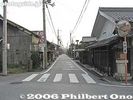
Nakasendo Road
|
|

Keihan train at Karahashi-mae Station.
|
|

Ujisato was married to Oda Nobunaga's second daughter Fuyuhime. He died at age 40. One theory says that he was poisoned by Toyotomi Hideyoshi. Entrance to Lord Gamo Ujisato's gravesite within Kotokuji temple in Aizu-Wakamatsu, Fukushima..
|
|
|
|

Trench or moat
|
|

Inside Omi Hino Merchant House
|
|
|

Little stone marker and shrine next to the bus stop.
|
|

Sumiyoshi Shrine torii. Notice the torches inside the shrine. 住吉神社 MAPEvery Jan., both this shrine and Katsube Shrine light giant torches for the festival's climax. Unfortunately, you cannot see the festival at both shrines since they are held around the same time. Sumiyoshi Shrine's fire festival is smaller with fewer (six) torches which represent the head of the slain dragon.
|
|
|
|

Approaching Kawamori. 川守
|
|

Starting line. The man says "Yoi" (Ready) then "Go."「用意」、次いで「ゴー」
|
|

Entrance to Itoh Chube'e Memorial House
|
|

Inside Toyosato Station.
|
|

You can buy a set of tickets to all four Omi merchant homes and the museum which cheaper than buying a ticket at each place. Ohmi Railways Gokasho Station 近江鉄道五箇所駅
|
|

These boat rides are offered only during this annual festival.
|
|

Gokasho was home to many Omi merchants who plied up and down Japan during the Edo Period to sell and trade their wares. They became quite successful selling medicines, lacquerware, sake, etc.Wall of former home of Omi merchant Tonomura Shigeru (1902-1961) (外村 繁邸).
|
|

Kachidoki (Victory) Bridge with race horse motif.
|
|

Univ. of Tokyo alumni crew in light blue T-shirts
|
|

National Diet members in Tokyo representing Shiga Prefecture. 滋賀の議員
|
|

Way to Takashimaya Dept. Store in Nihombashi subway station.
|
|

Imazu Port. A large crowd of people waiting to board the chartered boat for a 3-hour cruise on Lake Biwa to commemorate the 90th anniversary of the song, Biwako Shuko no Uta.
|
|
|
|

Most people were oblivious to the boats.
|
|

Entrance to the annex and a sign indicating the day's event or work. Today, July 7, 2007, was the Noritsuke Pasting Ceremony. 八日市大凧まつり のりつけ式
|
|
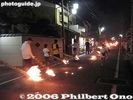
The torch procession goes from Gosha Shrine to Hibarino park.
|
|

Sixty rowing teams (300 people) rowed in five categories, including beginner and expert rowers, ranging in age from junior high to senior citizens.
|
|

Taga Taisha Shrine torii near Taga Taisha-mae Station. MAP
|
|

The regatta started at 9 am, and ended at about 4 pm. Omi-Ohashi Bridge in the background.
|
|

Convention Hall Omi at Otsu Prince Hotel. 第11回滋賀県人会世界大会のメイン会場。
|
|

Nomura-bashi Bridge crosses Anegawa River. This is where Oda Nobunaga battled the Azai clan.
|
|
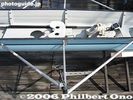
Rowing seat with moving seat on rails, fixed shoes, and outrigger for the oar.
|
|
|

Seta-no-Karahashi Bridge with the new paint job in 2012. 瀬田之唐橋
|
|

Entrance doors to Lord Gamo Ujisato's gravesite within Kotokuji temple which is a Zen temple of the Rinzai Sect.
|
|

Karasaki Pine Tree in Kenrokuen Garden, Kanazawa, Ishikawa Pref.
|
|
|

Path to shrine with stone lanterns, and cars.
|
|

Well used by the castle
|
|
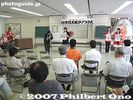
July 7, 2007: The making of the giant kite started with Noritsuke Pasting Ceremony where the new design was announced and dignitaries pasted together the first pieces of the kite paper.
|
|
|
|

Ishida Mitsunari is most famous for the Battle of Sekigahara in 1600 when he unsuccessfully led his Western Forces against Tokugawa Ieyasu's Eastern Forces
|
|

Sumiyoshi Shrine and the six giant torches.
|
|

Steps to Inari Shrine
|
|

Taiko drum beating
|
|

Kawamori bus stop, nearest to Mt. Yukinoyama.
|
|
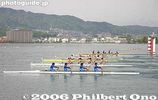
Four-man race starts with the cox at the front.
|
|

The photo above shows part of the stone monument for the first verse of the song. It reads "Ware wa Umi no Ko" (We're children of the lake). [url=http://photoguide.jp/txt/Lake_Biwa_Rowing_Song]More info about Lake Biwa Rowing Song here.[/uThis is the song's first and most famous line. The monument is in a small park near the former boathouse in Mihogasaki pier. The photo has been digitally altered (the colors are not real).
I visited and photographed all the places mentioned in the song as well as all the song monuments in Otsu, Omi-Maiko, Imazu, Chikubushima, Hikone, Chomeiji, and Okaya (Nagano). I also created some digital images to match the scenes mentioned in the song.
|
|

Entrance to Itoh Chube'e Memorial House
|
|
|
|

Ohmi Railways Gokasho Station, waiting room.
|
|

Welcome aboard!
|
|

Former home of Omi merchant Tonomura Shigeru (外村 繁邸). MapTonomura Shigeru (外村 繁), Tonomura Uhee (外村 宇兵衛), and Nakae Jungoro (中江 準五郎)
|
|

Bridge sidewalk.
|
|
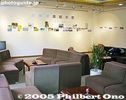
Title: Lake Biwa Rowing Song - In Pictures and in English Bunka Salon Gallery (also a coffee shop) inside Shiga Kaikan. 「琵琶湖周航の歌」〜写真と英語に〜The title was "Lake Biwa Boating Song - In Pictures and in English." I later changed the song title to "Lake Biwa Rowing Song."
Shiga Kaikan has two spaces for exhibitions, and I used the smaller space called Bunka Salon Gallery.
One entire wall and half of another wall were available for exhibitions free of charge.
|
|

Kyoto Univ. alumni crew in dark blue T-shirts
|
|

Each Diet member gave a short speech.
|
|
|
|

The "Rio Grande" cruise boat awaits at Imazu Port on a miraculously sunny day during the rainy season. 梅雨でありながら、奇跡的にこんないい天気になった。今津港
|
|

Stone for safe childbirth
|
|
|

This is the boat dock where people got on and off the boats. The boats were provided by local rowing organizations. The regatta was organized by the Seta Rowing Club in Otsu.
|
|

Road to Taga Taisha Shrine
|
|

The regatta was set for 300 meters. It was a hot, summer day.
|
|

Entrance to convention hall at Otsu Prince Hotel. Every few years, all the Shiga Kenjinkai in Japan and overseas gather for a convention for a few days.
|
|
|
|
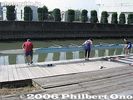
Carrying the boat to water.
|
|
|

The original Seta-no-Karahashi Bride was the site of historic battles. It has two bridges, one long and one short going over an island in the river.
|
|

My first and very small exhibition to introduce "Lake Biwa Rowing Song" in English. The English lyrics were still unfinished, so only an English translation was presented.I showed three images per verse (6 verses total), plus caption sheets and artist's message, boating map, and composer's biography on the other wall.
All the pictures were printed on A4 inkjet paper. Very low budget exhibition, but it caught the interest of one newspaper reporter. I later changed the song title to "Lake Biwa Rowing Song."
Exhibition Date & Time: Nov. 21 to Dec. 4, 2005, 9:30 am to 5:00 pm, closed Mon.
Map: http://www.shiga-bunshin.or.jp/shigakaikan/map.html
Address: Kyomachi 3-4-22, Otsu, Shiga Pref.
Phone: 077-525-9995
〒520-0044 大津市京町三丁目 4-22
Web site: http://www.shiga-bunshin.or.jp/shigakaikan/
|
|
|
|

Stone lanterns
|
|
| 18113 files on 72 page(s) |
1 |
 |
 |
 |
 |
|